Primordialbitch
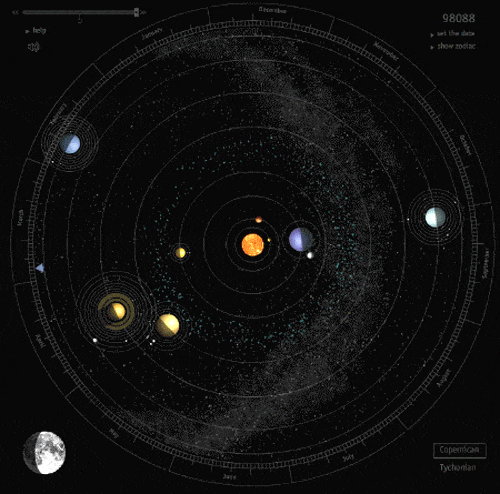
More Posts from Primordialbitch and Others
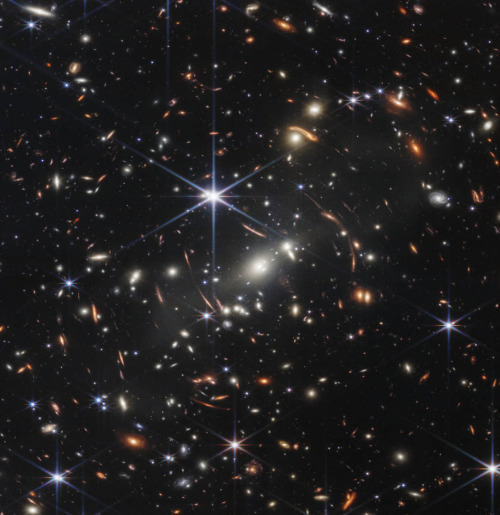
This first image from NASA’s James Webb Space Telescope is the deepest and sharpest infrared image of the distant universe to date. Known as Webb’s First Deep Field, this image of galaxy cluster SMACS 0723 is overflowing with detail. Thousands of galaxies – including the faintest objects ever observed in the infrared – have appeared in Webb’s view for the first time. This slice of the vast universe covers a patch of sky approximately the size of a grain of sand held at arm’s length by someone on the ground.
10 Things Einstein Got Right
One hundred years ago, on May 29, 1919, astronomers observed a total solar eclipse in an ambitious effort to test Albert Einstein’s general theory of relativity by seeing it in action. Essentially, Einstein thought space and time were intertwined in an infinite “fabric,” like an outstretched blanket. A massive object such as the Sun bends the spacetime blanket with its gravity, such that light no longer travels in a straight line as it passes by the Sun.
This means the apparent positions of background stars seen close to the Sun in the sky – including during a solar eclipse – should seem slightly shifted in the absence of the Sun, because the Sun’s gravity bends light. But until the eclipse experiment, no one was able to test Einstein’s theory of general relativity, as no one could see stars near the Sun in the daytime otherwise.
The world celebrated the results of this eclipse experiment— a victory for Einstein, and the dawning of a new era of our understanding of the universe.
General relativity has many important consequences for what we see in the cosmos and how we make discoveries in deep space today. The same is true for Einstein’s slightly older theory, special relativity, with its widely celebrated equation E=mc². Here are 10 things that result from Einstein’s theories of relativity:

1. Universal Speed Limit
Einstein’s famous equation E=mc² contains “c,” the speed of light in a vacuum. Although light comes in many flavors – from the rainbow of colors humans can see to the radio waves that transmit spacecraft data – Einstein said all light must obey the speed limit of 186,000 miles (300,000 kilometers) per second. So, even if two particles of light carry very different amounts of energy, they will travel at the same speed.
This has been shown experimentally in space. In 2009, our Fermi Gamma-ray Space Telescope detected two photons at virtually the same moment, with one carrying a million times more energy than the other. They both came from a high-energy region near the collision of two neutron stars about 7 billion years ago. A neutron star is the highly dense remnant of a star that has exploded. While other theories posited that space-time itself has a “foamy” texture that might slow down more energetic particles, Fermi’s observations found in favor of Einstein.

2. Strong Lensing
Just like the Sun bends the light from distant stars that pass close to it, a massive object like a galaxy distorts the light from another object that is much farther away. In some cases, this phenomenon can actually help us unveil new galaxies. We say that the closer object acts like a “lens,” acting like a telescope that reveals the more distant object. Entire clusters of galaxies can be lensed and act as lenses, too.
When the lensing object appears close enough to the more distant object in the sky, we actually see multiple images of that faraway object. In 1979, scientists first observed a double image of a quasar, a very bright object at the center of a galaxy that involves a supermassive black hole feeding off a disk of inflowing gas. These apparent copies of the distant object change in brightness if the original object is changing, but not all at once, because of how space itself is bent by the foreground object’s gravity.
Sometimes, when a distant celestial object is precisely aligned with another object, we see light bent into an “Einstein ring” or arc. In this image from our Hubble Space Telescope, the sweeping arc of light represents a distant galaxy that has been lensed, forming a “smiley face” with other galaxies.

3. Weak Lensing
When a massive object acts as a lens for a farther object, but the objects are not specially aligned with respect to our view, only one image of the distant object is projected. This happens much more often. The closer object’s gravity makes the background object look larger and more stretched than it really is. This is called “weak lensing.”
Weak lensing is very important for studying some of the biggest mysteries of the universe: dark matter and dark energy. Dark matter is an invisible material that only interacts with regular matter through gravity, and holds together entire galaxies and groups of galaxies like a cosmic glue. Dark energy behaves like the opposite of gravity, making objects recede from each other. Three upcoming observatories – Our Wide Field Infrared Survey Telescope, WFIRST, mission, the European-led Euclid space mission with NASA participation, and the ground-based Large Synoptic Survey Telescope — will be key players in this effort. By surveying distortions of weakly lensed galaxies across the universe, scientists can characterize the effects of these persistently puzzling phenomena.
Gravitational lensing in general will also enable NASA’s James Webb Space telescope to look for some of the very first stars and galaxies of the universe.

4. Microlensing
So far, we’ve been talking about giant objects acting like magnifying lenses for other giant objects. But stars can also “lens” other stars, including stars that have planets around them. When light from a background star gets “lensed” by a closer star in the foreground, there is an increase in the background star’s brightness. If that foreground star also has a planet orbiting it, then telescopes can detect an extra bump in the background star’s light, caused by the orbiting planet. This technique for finding exoplanets, which are planets around stars other than our own, is called “microlensing.”
Our Spitzer Space Telescope, in collaboration with ground-based observatories, found an “iceball” planet through microlensing. While microlensing has so far found less than 100 confirmed planets, WFIRST could find more than 1,000 new exoplanets using this technique.

5. Black Holes
The very existence of black holes, extremely dense objects from which no light can escape, is a prediction of general relativity. They represent the most extreme distortions of the fabric of space-time, and are especially famous for how their immense gravity affects light in weird ways that only Einstein’s theory could explain.
In 2019 the Event Horizon Telescope international collaboration, supported by the National Science Foundation and other partners, unveiled the first image of a black hole’s event horizon, the border that defines a black hole’s “point of no return” for nearby material. NASA’s Chandra X-ray Observatory, Nuclear Spectroscopic Telescope Array (NuSTAR), Neil Gehrels Swift Observatory, and Fermi Gamma-ray Space Telescope all looked at the same black hole in a coordinated effort, and researchers are still analyzing the results.

6. Relativistic Jets
This Spitzer image shows the galaxy Messier 87 (M87) in infrared light, which has a supermassive black hole at its center. Around the black hole is a disk of extremely hot gas, as well as two jets of material shooting out in opposite directions. One of the jets, visible on the right of the image, is pointing almost exactly toward Earth. Its enhanced brightness is due to the emission of light from particles traveling toward the observer at near the speed of light, an effect called “relativistic beaming.” By contrast, the other jet is invisible at all wavelengths because it is traveling away from the observer near the speed of light. The details of how such jets work are still mysterious, and scientists will continue studying black holes for more clues.

7. A Gravitational Vortex
Speaking of black holes, their gravity is so intense that they make infalling material “wobble” around them. Like a spoon stirring honey, where honey is the space around a black hole, the black hole’s distortion of space has a wobbling effect on material orbiting the black hole. Until recently, this was only theoretical. But in 2016, an international team of scientists using European Space Agency’s XMM-Newton and our Nuclear Spectroscopic Telescope Array (NUSTAR) announced they had observed the signature of wobbling matter for the first time. Scientists will continue studying these odd effects of black holes to further probe Einstein’s ideas firsthand.
Incidentally, this wobbling of material around a black hole is similar to how Einstein explained Mercury’s odd orbit. As the closest planet to the Sun, Mercury feels the most gravitational tug from the Sun, and so its orbit’s orientation is slowly rotating around the Sun, creating a wobble.

8. Gravitational Waves
Ripples through space-time called gravitational waves were hypothesized by Einstein about 100 years ago, but not actually observed until recently. In 2016, an international collaboration of astronomers working with the Laser Interferometer Gravitational-Wave Observatory (LIGO) detectors announced a landmark discovery: This enormous experiment detected the subtle signal of gravitational waves that had been traveling for 1.3 billion years after two black holes merged in a cataclysmic event. This opened a brand new door in an area of science called multi-messenger astronomy, in which both gravitational waves and light can be studied.
For example, our telescopes collaborated to measure light from two neutron stars merging after LIGO detected gravitational wave signals from the event, as announced in 2017. Given that gravitational waves from this event were detected mere 1.7 seconds before gamma rays from the merger, after both traveled 140 million light-years, scientists concluded Einstein was right about something else: gravitational waves and light waves travel at the same speed.

9. The Sun Delaying Radio Signals
Planetary exploration spacecraft have also shown Einstein to be right about general relativity. Because spacecraft communicate with Earth using light, in the form of radio waves, they present great opportunities to see whether the gravity of a massive object like the Sun changes light’s path.
In 1970, our Jet Propulsion Laboratory announced that Mariner VI and VII, which completed flybys of Mars in 1969, had conducted experiments using radio signals — and also agreed with Einstein. Using NASA’s Deep Space Network (DSN), the two Mariners took several hundred radio measurements for this purpose. Researchers measured the time it took for radio signals to travel from the DSN dish in Goldstone, California, to the spacecraft and back. As Einstein would have predicted, there was a delay in the total roundtrip time because of the Sun’s gravity. For Mariner VI, the maximum delay was 204 microseconds, which, while far less than a single second, aligned almost exactly with what Einstein’s theory would anticipate.
In 1979, the Viking landers performed an even more accurate experiment along these lines. Then, in 2003 a group of scientists used NASA’s Cassini Spacecraft to repeat these kinds of radio science experiments with 50 times greater precision than Viking. It’s clear that Einstein’s theory has held up!

10. Proof from Orbiting Earth
In 2004, we launched a spacecraft called Gravity Probe B specifically designed to watch Einstein’s theory play out in the orbit of Earth. The theory goes that Earth, a rotating body, should be pulling the fabric of space-time around it as it spins, in addition to distorting light with its gravity.
The spacecraft had four gyroscopes and pointed at the star IM Pegasi while orbiting Earth over the poles. In this experiment, if Einstein had been wrong, these gyroscopes would have always pointed in the same direction. But in 2011, scientists announced they had observed tiny changes in the gyroscopes’ directions as a consequence of Earth, because of its gravity, dragging space-time around it.

BONUS: Your GPS! Speaking of time delays, the GPS (global positioning system) on your phone or in your car relies on Einstein’s theories for accuracy. In order to know where you are, you need a receiver – like your phone, a ground station and a network of satellites orbiting Earth to send and receive signals. But according to general relativity, because of Earth’s gravity curving spacetime, satellites experience time moving slightly faster than on Earth. At the same time, special relativity would say time moves slower for objects that move much faster than others.
When scientists worked out the net effect of these forces, they found that the satellites’ clocks would always be a tiny bit ahead of clocks on Earth. While the difference per day is a matter of millionths of a second, that change really adds up. If GPS didn’t have relativity built into its technology, your phone would guide you miles out of your way!
Make sure to follow us on Tumblr for your regular dose of space: http://nasa.tumblr.com.
seeing the photos from Webb up against photos from Hubble just makes me… I don’t even know like, wow! Look at that!









shit man this got me emotional
Tabby's Star, not an Alien megastructure is the cause of dimming of the 'most mysterious star in the universe'

A team of more than 200 researchers, including Penn State Department of Astronomy and Astrophysics Assistant Professor Jason Wright and led by Louisiana State University’s Tabetha Boyajian, is one step closer to solving the mystery behind the “most mysterious star in the universe.” KIC 8462852, or “Tabby’s Star,” nicknamed after Boyajian, is otherwise an ordinary star, about 50 percent bigger and 1,000 degrees hotter than the Sun, and about than 1,000 light years away. However, it has been inexplicably dimming and brightening sporadically like no other. Several theories abound to explain the star’s unusual light patterns, including that an alien megastructure is orbiting the star.
Keep reading
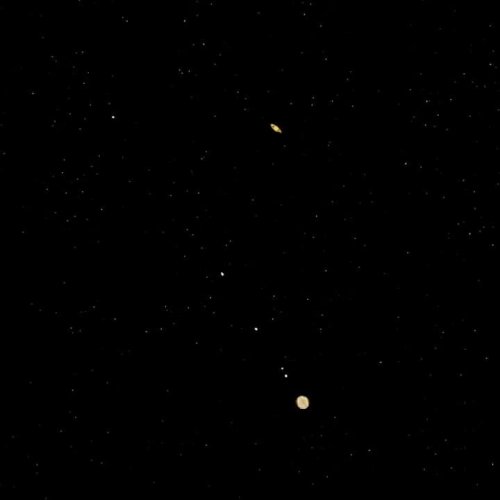
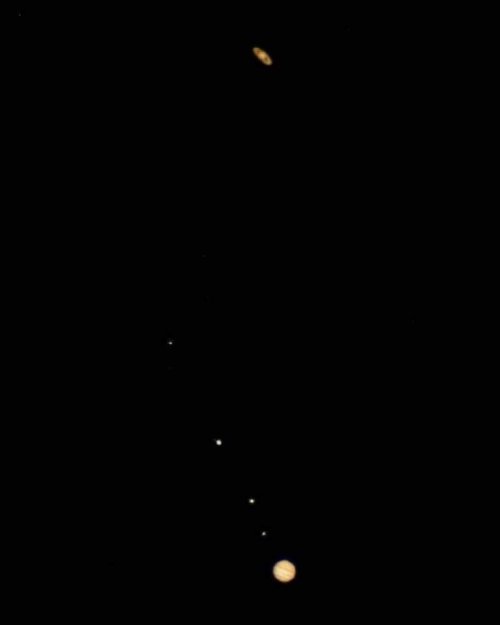
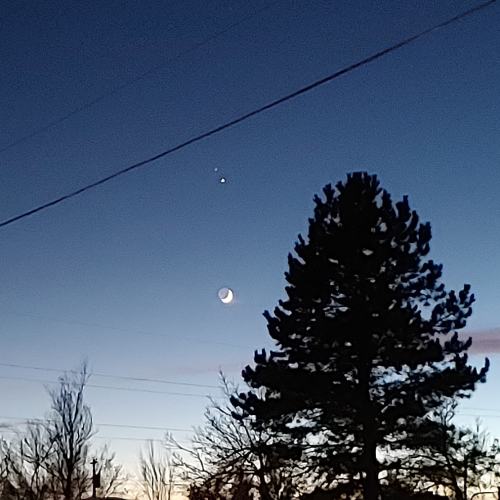
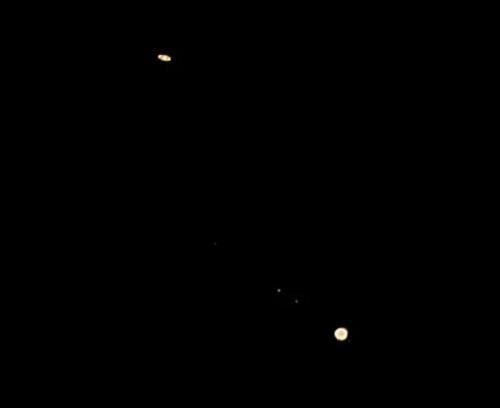
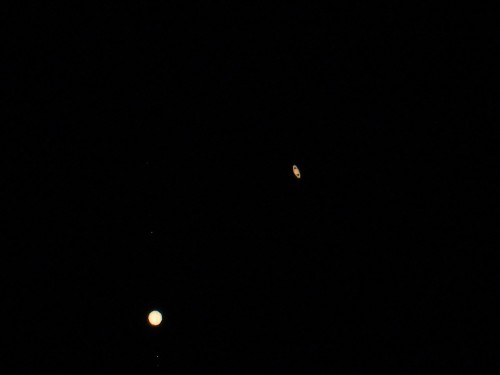
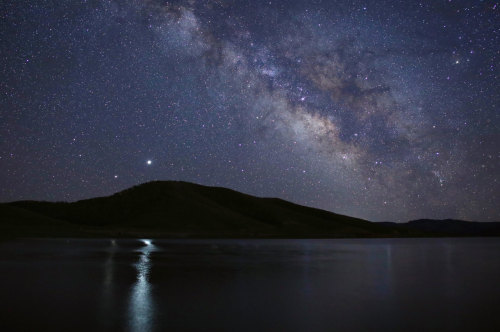
The Great Conjunction: Jupiter and Saturn 🌌.
Neutron Stars Collide
The recent detection of two neutron stars colliding has sent waves through spacetime and the astronomical community.
You may have seen headlines in the news and not really know why this is such a big deal.
Here’s the Sparknotes version:
A while back a thing called “gravitational waves” were observed for the first time. These are fluctuations in the fabric of spacetime that propagate out from their source just like light, i.e. radially/like a pebble dropped in water. General relativity shows us that the acceleration of objects with mass cause this event to occur.
Until fairly recently these have been too difficult to observe and in fact Einstein didn’t think we’d ever be able to. A series of laser interferometers have disproved that assumption. Using high-precision analysis of how the lasers shift as a gravitational wave moves through them scientists can now see the small movements in the universe that are gravitational waves.
Importantly, we now have three such observatories capable of working together. Known as the “LIGO-Virgo” team, two observatories in the U.S. and one in Italy detected these shifting in spacetime. Three is a pretty magical number in coordinating detections like this because you can then triangulate where the signal comes from and…
BINGO! Within hours optical observatories were zeroing in on the predicted source of these spacetime fluctuations. Indeed, they confirmed the presence of a previously unseen glow:

What you’re looking at is the glow of two neutron stars colliding into each other. This explosion has the energy of approximately 260,000,000 suns.
Each of these stars has such a large mass that the waves in spacetime are actually detectable from a distance of 140 million light-years away.
Impressive, right? Although you might agree, this still begs the question of what exactly we’ve learned from this event. Well - a lot. Since this is the first observation we have made with both gravitational wave observatories and more traditional astronomical observatories (i.e. light detecting ones) we’ve been able to put some numbers on the phenomenon. Here are some of the things we’ve learned:
1) Gravitational waves propagate at the speed of light!
2) A huge portion of heavier elements (like gold and uranium!) may have their origins in neutron star collisions! Nuclear synthesis in stars more typical like the sun is restricted to closer to 10% of the star’s mass being able to fuse elements together into new ones. This process is actually quite inefficient (actually, YOU are a more efficient radiator than the sun!) and it becomes more difficult for a star to fuse the heavier elements. Before this event we didn’t have a good way of explaining why we found so much more heavy stuff than stellar nuclear synthesis could account for. Now? Baboom! This neutron star collision resulted in the synthesis of so much gold that it’s about 150 times more massive than the Earth! Cha-Ching!
So if you’re an amateur (or professional, I suppose) astronomer and you want to see this collision, now dubbed GW170817, and you build a little radio telescope (another post!), you’ll be able to detect this collision for the next 5-10 years due to the afterglow.
(Image credit: NASA and ESA)
Red paint on 1,000-year-old gold mask from Peru contains human blood proteins

Thirty years ago, archeologists excavated the tomb of an elite 40-50-year-old man from the Sicán culture of Peru, a society that predated the Incas. The man’s seated, upside-down skeleton was painted bright red, as was the gold mask covering his detached skull. Now, researchers reporting in ACS’ Journal of Proteome Research have analyzed the paint, finding that, in addition to a red pigment, it contains human blood and bird egg proteins.
The Sicán was a prominent culture that existed from the ninth to 14th centuries along the northern coast of modern Peru. During the Middle Sicán Period (about 900–1,100 A.D.), metallurgists produced a dazzling array of gold objects, many of which were buried in tombs of the elite class. In the early 1990s, a team of archaeologists and conservators led by Izumi Shimada excavated a tomb where an elite man’s seated skeleton was painted red and placed upside down at the center of the chamber. Read more.
Pls tell me interesting facts about stars
Interesting facts about stars:
Heavy stars blow up and make heavier elements like gold. So, every bit of gold you’ve ever seen, worn, or touched came from the dying explosion of a star. Other elements made in supernovae include anything on the periodic table heavier than iron
Heavy stars blow up when they start fusing iron. Meaning, the iron in your frying pan, car, and your blood killed a star at least 3 times the mass of the sun.
Some massive stars that die end up compressing all their mass into a star about 6 miles across, or about the size of a city. This is called a neutron star.
To put this in perspective, these stars start out 3 times as big as our sun and all of their mass is crushed into something the size of a city. The space between atoms is squished away, and the protons and electrons combine to form neutrons.
Neutron stars are literally as dense as atomic nuclei
Most stars come in pairs
The most common stellar type is a red dwarf, which is a small, red, dim, cool star.
Honestly, that’s just the first few that come to mind, space is really crazy.
New type of star system? Mysterious radio signal puzzles astronomers
by Laura Nicole Driessen

Meerkat telescope. Sotiris Sanidas, Author provided
After observing a part of the sky near the Southern Constellation of Ara for about two months using MeerKAT, a radio telescope based in the Karoo desert in South Africa, our team of scientists noticed something strange. The radio emission of an object brightened by a factor of three over roughly three weeks.
Intrigued, we continued watching the object and followed this up with observations from other telescopes. We discovered that the unusual flare came from a binary star system – two stars orbiting each other – in our own galaxy. The finding, published in the Monthly Notices of the Royal Astronomical Society, has, however, turned out to be very difficult to explain.
Keep reading
-
 hypnoticreality liked this · 1 week ago
hypnoticreality liked this · 1 week ago -
 oh-no-mamma-mia liked this · 1 week ago
oh-no-mamma-mia liked this · 1 week ago -
 zenethemoon liked this · 2 weeks ago
zenethemoon liked this · 2 weeks ago -
 mymtvtime reblogged this · 2 weeks ago
mymtvtime reblogged this · 2 weeks ago -
 mxsbxhxv reblogged this · 2 weeks ago
mxsbxhxv reblogged this · 2 weeks ago -
 keturahhsgf liked this · 3 weeks ago
keturahhsgf liked this · 3 weeks ago -
 devilishschemes reblogged this · 3 weeks ago
devilishschemes reblogged this · 3 weeks ago -
 nozzur reblogged this · 3 weeks ago
nozzur reblogged this · 3 weeks ago -
 4sl4nz reblogged this · 3 weeks ago
4sl4nz reblogged this · 3 weeks ago -
 niconicot reblogged this · 3 weeks ago
niconicot reblogged this · 3 weeks ago -
 mili-77 liked this · 3 weeks ago
mili-77 liked this · 3 weeks ago -
 aydauzayda reblogged this · 3 weeks ago
aydauzayda reblogged this · 3 weeks ago -
 cloverkind liked this · 3 weeks ago
cloverkind liked this · 3 weeks ago -
 pre-scindible reblogged this · 3 weeks ago
pre-scindible reblogged this · 3 weeks ago -
 skinnyhyena liked this · 3 weeks ago
skinnyhyena liked this · 3 weeks ago -
 obensizmutluolamaz reblogged this · 3 weeks ago
obensizmutluolamaz reblogged this · 3 weeks ago -
 alien-police reblogged this · 3 weeks ago
alien-police reblogged this · 3 weeks ago -
 alien-police liked this · 3 weeks ago
alien-police liked this · 3 weeks ago -
 alleshelal reblogged this · 3 weeks ago
alleshelal reblogged this · 3 weeks ago -
 alleshelal liked this · 3 weeks ago
alleshelal liked this · 3 weeks ago -
 past4-any0ne reblogged this · 3 weeks ago
past4-any0ne reblogged this · 3 weeks ago -
 past4-any0ne liked this · 3 weeks ago
past4-any0ne liked this · 3 weeks ago -
 fleurduparadis reblogged this · 3 weeks ago
fleurduparadis reblogged this · 3 weeks ago -
 kafaminguzelligi reblogged this · 3 weeks ago
kafaminguzelligi reblogged this · 3 weeks ago -
 heart-of-mzelkowa reblogged this · 1 month ago
heart-of-mzelkowa reblogged this · 1 month ago -
 rockitmisa reblogged this · 1 month ago
rockitmisa reblogged this · 1 month ago -
 submissivebby444 reblogged this · 1 month ago
submissivebby444 reblogged this · 1 month ago -
 61sephin reblogged this · 1 month ago
61sephin reblogged this · 1 month ago -
 greekgoddesssss reblogged this · 1 month ago
greekgoddesssss reblogged this · 1 month ago -
 hurricanekate95 reblogged this · 1 month ago
hurricanekate95 reblogged this · 1 month ago -
 aligsmachine liked this · 1 month ago
aligsmachine liked this · 1 month ago -
 anhyatt9 liked this · 1 month ago
anhyatt9 liked this · 1 month ago -
 s-cordelia-mae liked this · 1 month ago
s-cordelia-mae liked this · 1 month ago -
 wedonttalkaboutrocco reblogged this · 1 month ago
wedonttalkaboutrocco reblogged this · 1 month ago -
 sharkskull liked this · 1 month ago
sharkskull liked this · 1 month ago -
 youngbloodthekilljoy liked this · 1 month ago
youngbloodthekilljoy liked this · 1 month ago -
 kachowwshrek liked this · 1 month ago
kachowwshrek liked this · 1 month ago -
 impossiblewizardtraveler-blog reblogged this · 1 month ago
impossiblewizardtraveler-blog reblogged this · 1 month ago -
 nuevegardenias liked this · 1 month ago
nuevegardenias liked this · 1 month ago -
 thatflowerinyourpocket reblogged this · 1 month ago
thatflowerinyourpocket reblogged this · 1 month ago -
 glaucidian liked this · 1 month ago
glaucidian liked this · 1 month ago -
 thastoopkid07 reblogged this · 1 month ago
thastoopkid07 reblogged this · 1 month ago -
 devotedartist liked this · 1 month ago
devotedartist liked this · 1 month ago -
 phaser350 reblogged this · 1 month ago
phaser350 reblogged this · 1 month ago -
 random-girl1997 reblogged this · 1 month ago
random-girl1997 reblogged this · 1 month ago -
 random-girl1997 liked this · 1 month ago
random-girl1997 liked this · 1 month ago -
 verynightmarecollection reblogged this · 1 month ago
verynightmarecollection reblogged this · 1 month ago -
 mrfandomwars reblogged this · 1 month ago
mrfandomwars reblogged this · 1 month ago -
 dylan23wilson reblogged this · 1 month ago
dylan23wilson reblogged this · 1 month ago -
 dylan23wilson liked this · 1 month ago
dylan23wilson liked this · 1 month ago
